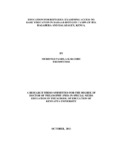| dc.description.abstract | The main objective of this study was to examine access to basic education for child
refugees in the Dadaab refugee camps of Ifo, Hagadera and Dagahaley,Kenya. The
study adopted a descriptive survey research design. The independent variables were
teaching/learning resources, physical facilities and socio-cultural practices while the
dependent variable was education. The target population comprised of primary school
head teachers, teachers, pupils and parents. Stratified random sampling was used to
sample schools to ensure proportionate distribution of schools within the camps. A
total of 10 primary schools were selected using stratified random sampling. This
formed 55.5% of the total population. From each selected school, the head teacher and
13 teachers were sampled for the study yielding 10 head teachers and 130 teachers.
From each school 13 class 7 pupils were randomly sampled and this yielded 130
pupils. In addition to the above respondents, 20 parents were conveniently sampled
and interviewed.The research instruments used were document analysis forms for
head teachers, questionnaires for teachers and pupils and interview schedules for
parents.A pilot study was done to establish the validity and reliability of the research
instruments. The calculated reliability coefficient using spearman brown prophecy
formula was 0.82.Data obtained was analyzed using descriptive statistics such as
frequencies, percentages, tables, graphs and charts. Discussions of the findings
established that in-school as well as out-of-school factors greatly hampered the access
to basic education in the schools for refugee children. Out of school factors included
such factors as lack of parental support, high levels of poverty, child labor and sociocultural factors which both affected the girl child more than the boy child. In-school
factors included lack of resources, untrained teachers, inadequate physical facilities
and lack of specialized equipment for learners with other disabilities.From the
findings of the study the researcher recommended that since majority of the camp
schools are registered with the Ministry of Education, the Directorate of Quality
Assurance and Standards should carry out advisory in these schools.The implementing
partners in the education programme should come up with incentives to motivate
learners in order to maintain them in school after enrollment,the Government of
Kenya through the Ministry of Education and the implementing partners should ensure
provision of adequate teaching/learning resources as well as specialized equipment for
learners with other disabilities in the camp schools. The education implementing
partners should come up with strategies of reducing gender disparities in education by
encouraging girls to remain in school and finally the school administration with the
help of implementing partners should organise ways of ensuring adequate provision of
physical facilities in the schools | en_US |

